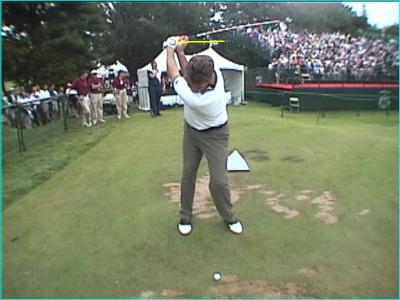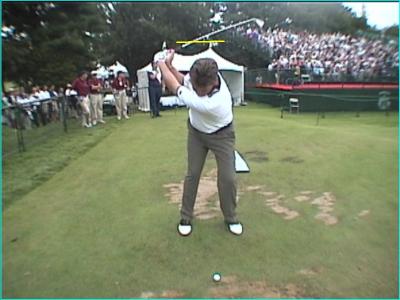The Fall In Tigers Transition Part 2
- by Kelvin Miyahira
Congratulations to the new Champion of Long Drive, Jamie Sadlowski. On October 25, 2008, he slammed it 418 yards in the final to be Dewald Gouws. On his way to the final Sadlowski also hit the longest drive of the event at a whopping 434 yards. He is certainly the best long driver pound for pound at about 5' 11" tall and about 175 pounds. He beat all of his taller, larger competitors like the 6' 8" tall, 300 pound Mike Dobbyn, who was the defending champion.
So what can we learn from him and other long drivers? Lots.
Last month we looked at the closed hip slide or bump that great athletes use. Whether it's a baseball slugger, Tiger or Jamie, it's pretty much the same move and it can really add some power and timing to your swing.
This month we'll take a close look at the arm and club movement during transition. When done properly, this move is really how lag begins and how you create help to develop the timing necessary to be consistent and powerful.
The Fall In
The “fall in" can be defined as the time when the club is falling to finish the backswing while the lower body has begun its slide to the left.
The most critical factor in doing this right is that maximum wrist set should be reached on the DOWNSWING. If one reaches maximum wrist setting on the backswing, it will set off a stretch shorten cycle in your hands and wrists to fire immediately thereafter. This point cannot be overemphasized.

Here's Tiger. His club falls in for 6 frames (using 60 frames per second camera).
As you can see, his club is falling in WHILE his hips have already started their move forward. This is so critical since everyone throws a ball with this same athletic move.
Jamie does the same.

Padraig Harrington does the same

Zero, zip, nada, no one throws a ball with their arm moving forward at the same time as the leg. This would be analogous to the golfer that pauses at the top of his/her backswing and then tries to start down together.
Counting frames
So their clubs move in the opposite direction from his lower body for six frames. Is this relevant or not? Probably. Well let's take a look at some other players with differing frame counts of falling it.
Too much
It is rare for a golfer to have too many frames of hip forward movement prior to the end of the club finishing. Because this is so rare, we shall skip the details of that move and concentrate on the mistake that most people make.
Too little
If we get too little or actually there is a way to get zero frames of fall in. That would be called a pause at the top of the backswing. Here's Lee Westwood with a pause at the top of his backswing and his weight clearly still on his right side.


The first picture is the top of the backswing and you can see he's still on his right side. Then as he starts the downswing, his arms, shoulders and hips are moving together with the club.

But isn't he casting? Oh, yes and do you think he can avoid it? Don't think so. If the root cause of the problem is in transition, it's really tough to mend it at this point.
To further analyze this, since his hips did not get out in front to lead the downswing, the shoulders dominate the motion. After a point, the shoulders run out of gas or rotation and the arms and hands begin to take over. So what you're seeing is the arms beginning to take over the downswing since the body is not driving it.
While he may be a great athlete that can overcome these swing flaws, he certainly isn't swinging as athletically as he can. Maybe some of us can feel a little better about our chicken wings now.
Recipe for Casting
But seriously, the loss of power, rhythm and timing in your swing is should be enough to scare you away from doing this.
Zuback type Lag Drill

To learn these movements it's as simple as one, two, three.
Conclusion
The bottom line is that if we fix the most critical part of the swing, the rest of the swing will get better. If not, all we're doing is fighting the flaw the rest of the way without ever finding the true cause. Then by doing this, we will be using our inborn athleticism and not our mechanical, analytical mind since instinctual and athletic moves are more repeatable, powerful and require less thinking.
So what can we learn from him and other long drivers? Lots.
Last month we looked at the closed hip slide or bump that great athletes use. Whether it's a baseball slugger, Tiger or Jamie, it's pretty much the same move and it can really add some power and timing to your swing.
This month we'll take a close look at the arm and club movement during transition. When done properly, this move is really how lag begins and how you create help to develop the timing necessary to be consistent and powerful.
The Fall In
The “fall in" can be defined as the time when the club is falling to finish the backswing while the lower body has begun its slide to the left.
The most critical factor in doing this right is that maximum wrist set should be reached on the DOWNSWING. If one reaches maximum wrist setting on the backswing, it will set off a stretch shorten cycle in your hands and wrists to fire immediately thereafter. This point cannot be overemphasized.

Here's Tiger. His club falls in for 6 frames (using 60 frames per second camera).
As you can see, his club is falling in WHILE his hips have already started their move forward. This is so critical since everyone throws a ball with this same athletic move.
Jamie does the same.

Padraig Harrington does the same

Zero, zip, nada, no one throws a ball with their arm moving forward at the same time as the leg. This would be analogous to the golfer that pauses at the top of his/her backswing and then tries to start down together.
Counting frames
So their clubs move in the opposite direction from his lower body for six frames. Is this relevant or not? Probably. Well let's take a look at some other players with differing frame counts of falling it.
Too much
It is rare for a golfer to have too many frames of hip forward movement prior to the end of the club finishing. Because this is so rare, we shall skip the details of that move and concentrate on the mistake that most people make.
Too little
If we get too little or actually there is a way to get zero frames of fall in. That would be called a pause at the top of the backswing. Here's Lee Westwood with a pause at the top of his backswing and his weight clearly still on his right side.


The first picture is the top of the backswing and you can see he's still on his right side. Then as he starts the downswing, his arms, shoulders and hips are moving together with the club.

But isn't he casting? Oh, yes and do you think he can avoid it? Don't think so. If the root cause of the problem is in transition, it's really tough to mend it at this point.
To further analyze this, since his hips did not get out in front to lead the downswing, the shoulders dominate the motion. After a point, the shoulders run out of gas or rotation and the arms and hands begin to take over. So what you're seeing is the arms beginning to take over the downswing since the body is not driving it.
While he may be a great athlete that can overcome these swing flaws, he certainly isn't swinging as athletically as he can. Maybe some of us can feel a little better about our chicken wings now.
Recipe for Casting
- Set wrists early on the backswing
- Pause at the top of backswing with your weight on your right side
- Start downswing with arms, shoulders and hips together
But seriously, the loss of power, rhythm and timing in your swing is should be enough to scare you away from doing this.
Zuback type Lag Drill

To learn these movements it's as simple as one, two, three.
- Start with a later wrist cock. Zuback is actually doing a reverse wrist cock in this animation.
- As you complete the backswing, try to sense the fall in and accompanying left shift starting.
- Complete the weight transfer with your tailbone feeling like it's moving to the target and let the arms/club drop into the slot.
Conclusion
The bottom line is that if we fix the most critical part of the swing, the rest of the swing will get better. If not, all we're doing is fighting the flaw the rest of the way without ever finding the true cause. Then by doing this, we will be using our inborn athleticism and not our mechanical, analytical mind since instinctual and athletic moves are more repeatable, powerful and require less thinking.

